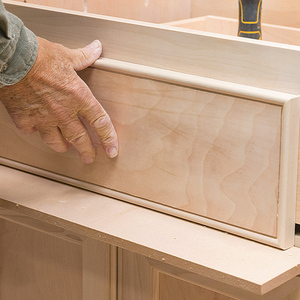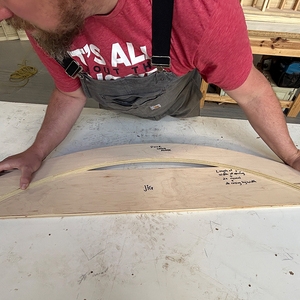*
Background: I’m a DIYer with enough experience to hopefully not embarrass myself. Or maybe it’s just enough experience to get myself into trouble.
Existing House: 2 and 1/2 story frame mainhouse footprint beside attached 2 car garage with bonus room above.
Project: 2 Story Addition (1st floor workshop, 2nd floor finished walk-in closet) attached behind garage. Addition is 12 feet wide at the junction with garage and projects 16 feet behind the garage. Foundation is monolithic slab with integral footing.
Problem: Grade slopes away from back of garage to a maximum of 16 inches. Slope profile is approximate 0-4 inch drop in the first 8 feet away from garage and 4-16 inch drop from 8 feet out to 16 feet from the garage. A tree was approximate 13 feet out from the back of the garage and has now be removed. No major roots remain. Hole left is approximate 16 inches deep by 5 foot diameter. So the grade issue is to fill the tree hole and grade up 16 inches to support the slab. With 45 degree angle transition between slab and footing, the 4 inch slab area will be approximately 8 feet wide by 12 feet deep.
Question: Unfortunately this is one of those questions where I’m asking if I’m in trouble rather than how not to get into trouble. However, if I’m in a little trouble, I think there is at least one relatively easy solution.
I have filled the tree hole layer by layer manual tamping with a 10×10 tamper as I went. However, when it came to the main effort of increasing the grade, I just shoveled dirt until I was above the grade line I wanted. Only after the grade was close did I compact. I’ve subjected to new grade to 3 plus hours of compacting with a 14 inch plate compactor.
b Surface seems well compacted but I’m worried I’ve done nothing underneath and am subject to settling.
Assumptions: I’m assuming that because footings will be located on undisturbed earth at the proper depth, foundationally my only main concern is slab cracking due to poor compaction.
b Is this accurate or have I missed something???
Possible solution: If my compaction job was terrible and I’m in trouble, I’m hoping that I can go into the grade area and auger through at two places and create CMU piers equally spaced in the center line of the slab. I’m theorizing that this is enough support (8 x 12 foot 4 inch slab with piers at 4 and 8 feet within the 12 foot dimension and centered at 4 feet within the 8 foot dimension) that my cracking potential will have been minimized.
b Ok. Am I anywhere close to the right track or have I completely embarrassed myself???
Slings and arrows cheerfully accepted.



















Replies
*
What you did is normal for soil compaction. Alot of contractors have done it this method. It really depends on the type material used for backfill. If it was a very sandy loam or sand clay, you will not have no problems. If it had a medium amount of clay but still a sand clay it would take a little more effect.
To put your mind at ease, find a smooth rod and drive into ground, paying attention to how many blows to move. If its hard then get easy, more compaction is needed. If its hard to drive to grade, feel at ease.
*What Johnnie said is correct. A normal "lift" when building a pad up is no more than 6 inches of fill that should be compacted at one time. Soil composition makes a big difference as does moisture content. The slick rod probe is a good idea, but a "roll test" is better. Commercial slabs a generally roll tested with a loaded dual axle dump truck. That might be a little extreme in your case, but I bet a pick up truck loaded with grillage(I love that word, means gravel) would show you where your soft spots are located. Once you identify the areas you can dig them out and refill them with the correct lift intervals and compaction. Then repeat the roll test agian. If every thing test ok, then use the rock under your slab.I've seen other guys use the posthole trick to try to reduce slab failure from poor compaction, but I don't know if it works. I would use grade beams and tie in more steel in the form of a 2x2 grid. Post hole just don't seem like they would support a slab enough, but maybe others here know a better way. Good luck.Dave
*Andrew,At least you are asking questions. Next time ask before the task at hand.If you are going to go through the effort of loading up a truck with gravel to test your pad, well than just drive back and forth over the fricken pad and I'm sure it will be more compact than you have it now. Don't even bother testing if you gone to that length.The concrete work I have performed here, in the San Francisco Bay Area, and I'm sure you will agree, requires the highest standards globally. I won't take you to those extremes, unless you do live in this region. The proper way to perform this task, as suggested earlier, would have been with a fill designed to meet this requirement. (class II base rock around here) Bring it up in lifts and compact in between with a wacker or sheeps foot. Ask your rental yard about this stuff. If you are truly interested to see if your pad is stiff enough, you can contact a service which will perform a test to determine the compaction of your pad. It is done with a rod, however thier rod is intergrated with a mechinism designed to measure soil density.By the way, how about the base material you are covering up or essentially where the new pad will be located. Is it of adequate compaction to accept your new addition? The fact that it is undisturbed soil is not always a sufficient situation. You may simply choose to ask your local building official of other similar projects in the neighborhood and what was required.The area in question is not that big. The last part which you topped off, you may want to scratch off half the layer and rent a wacker and really pack it in good. If the 14 inch plate you were describing is the i vibraplate, I don't believe it did the job for you.Start off on the right foot. Don't start cutting corners already.I didn't want to have to remind you, but every great endeavor begins with a good b foundation!Just one man's opinion. p s Take the trouble and generate a level subgrade. It will make the the subsequent tasks that much easier. rebar...screeds...etc...
*Mark, roll testing is just that, a test to find soft spots. Even running a highlift across a pad won't give you a 90% compaction proctor reading.A whacker, sheeps foot, or plate vibrator all depend on vibration to consolidate the soil. Any one of them will work if the correct lift are used.I agree with you that if Andrew is really concerned he can have a compaction test run. I was suggesting the roll test because we always are reguired to run them even after the proctors. We almost always find soft spots that were missed.Dave
*What everybody is saying here is correct although different methods, they are all correct. I work for a testing lab as a field tech for the last 17 years. i really like the proofroll method over other because if it will hold a 30 ton dump truck it will hold anything. But not everybody has a dump truck. I also agree that the sand sled is really no help except for sand in three inch lifts or slicking asphalt. The pickup will help although it will not compact deep. I did mine this way. A wacker "jumping jack" will solve the problem, you better be young, it will work you a$$ off. Material,moisture,method. also some people believe that nature undistrube(sp) material is compacted, I have proof this wrong too. If you are using pure sand like we do it, it can be compacted with a fire hose, like the beach tight at the water line. rent you a jumping jack, spend a saturday morning and you be O.K.
*Thanks for the answers.I did the smooth rod test and I've got soft spots. Smooth rod test on my preexisting grade (a drainage route beside my pad) showed softer grade than I expected down to about 1 foot level, then it was firm.Unfortunately, at this point ... while I am prepared to do so ... I'd rather find an alternative to scratching off the fill and recompacting. It seems to be implied above that a Wacker will compact what I've got (max 32" sandy clay fill over red North Carolina clay grade) but if I have soft pre-existing grade that needed compaction, I really need to scratch and compact. b Johnnie, what do you think??? Being that I'm dealing with clay, is this Wacker machine really enough to deal with what I've got without pulling up the top half???The "grade beam" idea mentioned sounds interesting.b Does this mean basically digging another trench and pouring a reinforced footing centered across one of the dimensions of my slab?Any other ideas??? Massive rebar grid, piers, anything??? I'm only calulating that there's about 1.50 yards of slab which works out to about 6000 lbs. With the footing bearing some of that weight, a couple square feet of area in two piers bearing on 2000 psf soil and some rebar seem like they could deal with the tributary load of any sag. Anyway, I'm soliciting honest feedback but will do the right thing. If there's no real alternative, I'm going to pull it up and recompact.Thanks much.
*
Background: I'm a DIYer with enough experience to hopefully not embarrass myself. Or maybe it's just enough experience to get myself into trouble.
Existing House: 2 and 1/2 story frame mainhouse footprint beside attached 2 car garage with bonus room above.
Project: 2 Story Addition (1st floor workshop, 2nd floor finished walk-in closet) attached behind garage. Addition is 12 feet wide at the junction with garage and projects 16 feet behind the garage. Foundation is monolithic slab with integral footing.
Problem: Grade slopes away from back of garage to a maximum of 16 inches. Slope profile is approximate 0-4 inch drop in the first 8 feet away from garage and 4-16 inch drop from 8 feet out to 16 feet from the garage. A tree was approximate 13 feet out from the back of the garage and has now be removed. No major roots remain. Hole left is approximate 16 inches deep by 5 foot diameter. So the grade issue is to fill the tree hole and grade up 16 inches to support the slab. With 45 degree angle transition between slab and footing, the 4 inch slab area will be approximately 8 feet wide by 12 feet deep.
Question: Unfortunately this is one of those questions where I'm asking if I'm in trouble rather than how not to get into trouble. However, if I'm in a little trouble, I think there is at least one relatively easy solution.
I have filled the tree hole layer by layer manual tamping with a 10x10 tamper as I went. However, when it came to the main effort of increasing the grade, I just shoveled dirt until I was above the grade line I wanted. Only after the grade was close did I compact. I've subjected to new grade to 3 plus hours of compacting with a 14 inch plate compactor.
b Surface seems well compacted but I'm worried I've done nothing underneath and am subject to settling.
Assumptions: I'm assuming that because footings will be located on undisturbed earth at the proper depth, foundationally my only main concern is slab cracking due to poor compaction.
b Is this accurate or have I missed something???
Possible solution: If my compaction job was terrible and I'm in trouble, I'm hoping that I can go into the grade area and auger through at two places and create CMU piers equally spaced in the center line of the slab. I'm theorizing that this is enough support (8 x 12 foot 4 inch slab with piers at 4 and 8 feet within the 12 foot dimension and centered at 4 feet within the 8 foot dimension) that my cracking potential will have been minimized.
b Ok. Am I anywhere close to the right track or have I completely embarrassed myself???
Slings and arrows cheerfully accepted.